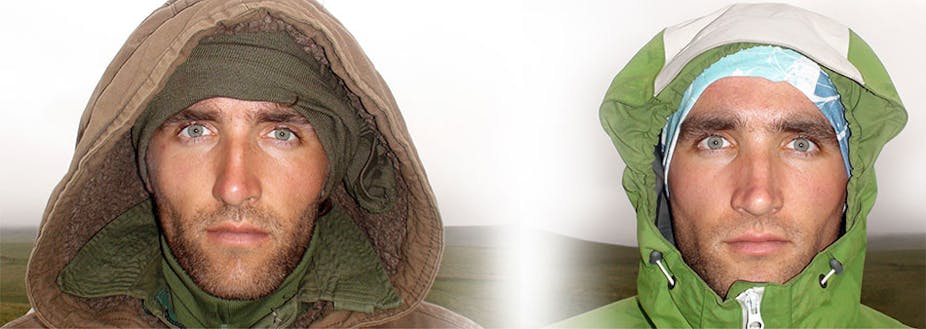Hugo and Ross Turner are a pair of intrepid twins currently on an expedition to Greenland. One of them, Ross, is using the same style of equipment and facilities used by Ernest Shackleton 100 years ago in his famous Endurance expedition to Antarctica. He’s having an early 20th century polar expedition diet and pulling a 1900s-style sled.
Hugo on the other hand is making use of the most advanced technology and equipment available to today’s explorers. The two of them will therefore experience the arctic environment very differently. The effect it will have on their bodies, which are genetically identical, is at the heart of research into identifying how different diseases develop and the role our genes and lifestyles play in causing them.
Natural science experiment
Twins provide a unique natural experiment for scientific research. Identical twins share 100% of their genes and non-identical twins share 50%. Through comparing the differences and similarities between them, we can identify whether a disease is due to a genetic predisposition or environmental factors.
If we find that identical twin pairs are more likely to both have a disease or a trait than non-identical twins, then the disease is more likely to have a strong genetic component. If, however, our identical twins are no more similar than our non-identical twins, it is more likely that the disease is caused by environmental or lifestyle factors.
The Department of Twin Research hosts TwinsUK, the biggest adult twin registry in the UK and has collected a wealth of data from twin volunteers over 21 years from clinical visits and detailed questionnaires. This enables us to look at our twins’ genetics, epigenetics and gut Microbiome. This extensive information on more than 6,000 traits allows us to identify the role that our lifestyle and genetics play in many diseases such as type 2 diabetes, heart disease and osteoarthritis.
Genes versus environment
Science has reached a crucial point in determining how human health is determined by our genetic makeup or environmental factors. Previously the community was divided: one camp firmly believed that genetics was the answer to all of our diseases, while the other felt that it was all to do with our environment and lifestyle. More recently, however, a third epigenetic camp has emerged, showing how our environment and lifestyle can actually change the way our genes work and affect our health and ageing.
Epigenetic changes occur most dramatically in the womb and in early childhood. They have a key role in turning the right genes on and off at the right time so that we grow and develop appropriately. These changes slow down once we reach adulthood with changes only occurring every few years throughout our tissues. But we now know that our lifestyle has an impact on these changes. For example, smoking can cause these chemical tags to bind to our DNA and switch genes on and off, predisposing us to diseases such as cancer.
We are able to look at twins who are genetically identical, but where only one contracts a disease (such as type 2 diabetes), to see what epigenetic differences are present in the run up to the development of and after the onset of the disease.
We are also beginning to understand the role that our gut Microbiome – often referred to as the forgotten organ – has on our health. We naturally have trillions of bacteria within our gut, which all together can weigh up to two kilos. These bacteria have evolved with us and are vital for our survival; helping us to digest our food and keep us healthy.
Studying twins can help us understand how the presence of certain bacteria or having the wrong proportions of bacteria is associated with diseases including obesity and diabetes. We are currently collecting fecal samples on 5,000 of our twins and, along with the wealth of information we have on their lifestyles and genetics, this will further help us investigate the role that microbes in our guts play in both health and disease.
Polar project
Hugo and Ross have allowed us to collect a huge range of biological samples and lifestyle information prior to and after their Greenland expedition. These include their height, weight, blood pressure, fat and muscle mass, bone density, a wide range of blood tests, a blood DNA sample so that we can look at any epigenetic changes that may occur and a faecal sample for an insight into their guts. Comparing these results before they began their training, immediately before they embarked on their expedition and when they get back, we can get a good idea of how the environment affected them both.
As Hugo and Ross are identical twins and share 100% of their DNA, any differences we see between their results at the end of the research we can assume will be mainly due to the different environmental exposures they encountered. Whether we will see that Ross has suffered more by using less sophisticated equipment and provisions than Hugo remains to be seen. But either way we are excited to be able to take part in this unique and extreme test of genes versus environment, and better understand the interplay between environmental factors and genetics in disease and health.

